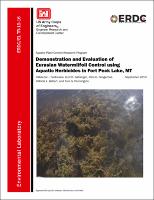Please use this identifier to cite or link to this item:
https://hdl.handle.net/11681/33991Full metadata record
| DC Field | Value | Language |
|---|---|---|
| dc.contributor.author | Getsinger, Kurt D. | - |
| dc.contributor.author | Podkowka, Rebecca L. | - |
| dc.contributor.author | Skogerboe, John G. | - |
| dc.contributor.author | Gilbert, Patricia L. | - |
| dc.contributor.author | Pennington, Toni Garrett | - |
| dc.date.accessioned | 2019-09-09T19:46:41Z | - |
| dc.date.available | 2019-09-09T19:46:41Z | - |
| dc.date.issued | 2019-09 | - |
| dc.identifier.govdoc | ERDC/EL TR-19-16 | - |
| dc.identifier.uri | https://hdl.handle.net/11681/33991 | - |
| dc.identifier.uri | http://dx.doi.org/10.21079/11681/33991 | - |
| dc.description | Technical Report | - |
| dc.description.abstract | Eurasian watermilfoil (EWM) was first observed in Fort Peck Lake, MT in 2010 and has spread to over 100 locations in the lake. In 2012, field trials were conducted to evaluate aquatic herbicides for controlling EWM and provide management guidance. This work follows those initial 2012 demonstrations. Five sites were identified for herbicide treatments and bulk water exchange processes were determined using inert tracer dye, rhodamine WT (RWT). Field trials conducted in 2014 spanned two growing seasons, summer (July) and fall (September). Treatments were with a variable-depth application technique, or for one plot, a hand gun from the surface. Vegetative communities were assessed at pretreatment, and at 8 and 52 weeks. Non-target native vegetation was sparse pretreatment in all plots, but generally survived treatments. Treatments had no impacts on water quality measured in the field, including dissolved oxygen levels. Control of EWM was limited (< 50%) in small, open-water plots treated with diquat and endothall, where no barrier curtains were deployed. Control of EWM was near 100% through one year after treatment in plots where barrier curtains mitigated bulk water exchange processes and extended herbicide contact times were maintained. | en_US |
| dc.description.sponsorship | Aquatic Plant Control Research Program (U.S.) | en_US |
| dc.description.sponsorship | United States. Army. Corps of Engineers. Omaha District. | - |
| dc.description.tableofcontents | Abstract ........................................................................................................................................................ Figures and Tables ...................................................................................................................................... iii Preface........................................................................................................................................................ v Unit Conversion Factors ............................................................................................................................... vi Acronyms and Abbreviations ........................................................................................................................ vii 1 Introduction ........................................................................................................................................ 1 1.1 Background ....................................................................................................................... 1 1.2 Approach ........................................................................................................................... 1 1.3 Scope ................................................................................................................................ 2 1.4 Environmental setting ......................................................................................................... 2 1.4.1 Hydrology ................................................................................................................................. 2 1.4.2 Climatic conditions ................................................................................................................... 3 1.5 Objectives .......................................................................................................................... 3 2 Materials and Methods......................................................................................................................... 4 2.1 Description of treatment plots .............................................................................................. 4 2.2 Site preparation ................................................................................................................. 6 2.2.1 Treatment plots DC-1, DC-4 and ES-6 ......................................................................................... 6 2.2.2 Treatment Plots DC-2 and DC-3 .................................................................................................. 7 2.3 Vegetation assessments ...................................................................................................... 7 2.4 Herbicide products ........................................................................................................... 10 2.5 Treatment schedule, herbicide rates, and application techniques .......................................... 13 2.6 Water quality .................................................................................................................... 16 3 Results and Discussion ....................................................................................................................... 17 3.1 Environmental conditions .................................................................................................. 17 3.2 Water Exchange Processes ................................................................................................ 17 3.2.1 July 2014 ............................................................................................................................... 17 3.2.2 September 2014 .................................................................................................................... 22 3.3 Plant Assessments and CET ............................................................................................... 28 4 Conclusions and Recommendations .................................................................................................... 37 4.1 Conclusions ..................................................................................................................... 37 4.2 Recommendations ............................................................................................................ 38 References ............................................................................................................................................... 40 Appendix A: Product Label Use Restrictions .................................................................................................. 44 Appendix B: Raw Plant Data Frequency of Occurrence ................................................................................... 46 Appendix C: Rhodamine WT Fluorescent Dye for Use in Determining Bulk Water Exchange Processes, as Related to Aquatic Herbicide Applications ............................................................................................ 48 Report Documentation Page | - |
| dc.format.extent | 63 pages / 4.746 Mb | - |
| dc.format.medium | - | |
| dc.language.iso | en_US | en_US |
| dc.publisher | Environmental Laboratory (U.S.) | en_US |
| dc.publisher | Engineer Research and Development Center (U.S.) | - |
| dc.relation.ispartofseries | Technical Report (Engineer Research and Development Center (U.S.)) ; no. ERDC/EL TR-19-16 | - |
| dc.rights | Approved for Public Release; Distribution is Unlimited | - |
| dc.source | This Digital Resource was created in Microsoft Word and Adobe Acrobat | - |
| dc.subject | Aquatic plants--Control | en_US |
| dc.subject | Eurasian watermilfoil | en_US |
| dc.subject | Aquatic herbicides--Evaluation | en_US |
| dc.subject | Fort Peck Lake (Mont.) | en_US |
| dc.title | Demonstration and evaluation of eurasian watermilfoil control using aquatic herbicides in Fort Peck Lake, MT | en_US |
| dc.type | Report | en_US |
| Appears in Collections: | Technical Report | |
Files in This Item:
| File | Description | Size | Format | |
|---|---|---|---|---|
| ERDC-EL TR-19-16.pdf | 4.86 MB | Adobe PDF |  View/Open |